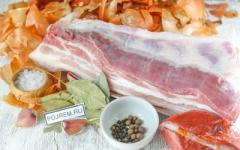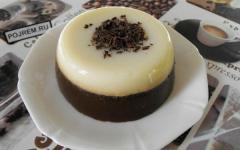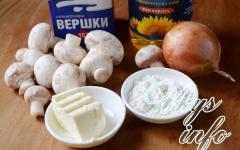Borodino bread is one of the most famous products of USSR times. A distinctive feature of the variety is the sprinkling of cumin or coriander. It is the characteristic, incomparable aroma of Borodino bread that has made this product so beloved by many generations.
How many calories are in Borodino bread?
People involved in sports often ask: “how many calories are in Borodino bread?” The calorie content of Borodino bread per 100 grams is 207 kcal. The calorie content of Borodino bread is several times less than that of the wheat variety. The difference is due to the fact that only 15% rye flour is used in our type of bread.
Energy value of the product: Proteins - 6.8 g (about 27 kcal). Fats - 1.3 g (about 12 kcal); Carbohydrates - 40.7 g (about 163 kcal).
Ratio of proteins, fats and carbohydrates: 13%; 6%; 79%. The nutritional value of Borodino bread is optimal for people watching their diet.
The nutritional value of Borodino bread is ideal for breakfast. And the taste of Borodino bread goes well with raw smoked sausage, sprats, herring, butter, cucumbers and cherry tomatoes.

Chemical composition of Borodino bread
Borodino bread is baked mainly from two types of flour - rye and peeled; some manufacturers add a third type - wheat flour. According to GOST, the composition of Borodino bread should not contain more than 15% rye. We present the composition of Borodino bread in accordance with GOST. The recipe includes rye and wheat flour, salt, sugar, coriander.

The product has a chemical composition rich in a variety of vitamins, micro- and macroelements, and other beneficial substances.
If we talk about the vitamin composition, the leading positions in Borodino bread are occupied by B vitamins. There is especially a lot of thiamine, choline, folates, all of these are B vitamins. Depending on the vitamin group, Borodino bread contains from 7 to 14% of the daily value. There is also a particularly high amount of vitamin PP here - 11% of the daily value. Borodino bread, the benefits of which directly follow from its composition, also contains beta-carotene.
In the macronutrient composition, the leaders here are silicon, sodium, and phosphorus - they each account for 19% of the daily value. Borodinsky is not deprived of potassium and magnesium.
The microelement composition is also extensive, with iron, copper, zinc, manganese, and chromium being the leaders.
In addition to proteins, fats, carbohydrates, vitamins, micro- and macroelements, Borodinsky bread boasts a large amount of fiber - almost 8 grams out of 100.
What are the benefits of Borodino bread?
The rich composition of B vitamins has a positive effect on the human nervous and cardiovascular system. Food rich in these substances affects the quality of hair, nails, and skin. By eating Borodino bread, you take care not only of health, but also of beauty. The benefits of Borodino bread for women who want to impress with beautiful hair, strong nails and velvety skin are obvious.
Other components of the product, in particular potassium and magnesium, also have a positive effect on the cardiovascular system. Eating Borodino bread will help normalize high blood pressure and have a beneficial effect on blood composition. The product will also help strengthen blood vessels and rid the body of waste and toxins.
Coarse dietary fiber, otherwise known as fiber, helps cleanse the intestines and normalize the functioning of the stomach. Fiber will also relieve the feeling of hunger, even if you eat a small portion of food. The fact is that, once in the stomach, coarse dietary fibers swell, creating the effect of a full stomach.
The product is useful for people suffering from gout or hypertension. Due to its high fiber content, bread normalizes digestion.
The benefits of Borodino bread for weight loss
Borodino bread can have both benefits and harm on your figure. On the one hand, the product belongs to bakery products, the consumption of which must be reduced in order to lose weight. On the other hand, we just talked about the benefits of fiber, which can normalize weight by eliminating waste and toxins and suppressing appetite.
As they say, everything is learned by comparison. If you compare regular white bread and black Borodino bread, it’s easy to find that the second option is much healthier for your figure. It contains fewer calories and more nutrients, which should not be deprived of the body even during a diet. At the same time, many cannot give up the habit of eating many dishes with bread. This is where Borodinsky's loaf comes in handy.
Moreover, this product has a positive effect on the metabolism in the body, and this is a good way to lose weight. Sometimes you can afford a piece of Borodino bread even on a diet.
What is the harm from Borodino bread?
People with high stomach acidity and diabetes should avoid Borodino bread. People with gluten intolerance should not eat the aromatic delicacy, otherwise a dangerous allergic reaction may occur.
What should people on a diet do who cannot do without bread? An alternative to white rolls made from high-grade flour can be Borodino black bread. Although this bread can hardly be called dietary in terms of calorie content, due to its beneficial qualities this product will help you in the difficult task of losing weight. Of course, this does not mean that it is possible to eat a lot of Borodino bread and still be on a diet, but if you allow yourself a couple of pieces, it will even be beneficial.
Rumors are growing around Borodino bread that it is, in principle, dietary, because it contains rye flour. It is believed that it is due to this that the calorie content of the product is reduced. However, this stereotype is dispelled when information is received that this flour is only 15% in the recipe.
How many calories are in Borodino bread?
 Most people believe that brown bread has much fewer calories than white bread, but this is a misconception. Borodino bread contains 210 kcal per 100 g, while 100 g of white wheat bread contains 260 kcal, the difference is small. Although Borodino bread cannot be called a dietary product, it is much healthier than other flour products, so if you are in the process of losing weight, then it is better to eat Borodino bread.
Most people believe that brown bread has much fewer calories than white bread, but this is a misconception. Borodino bread contains 210 kcal per 100 g, while 100 g of white wheat bread contains 260 kcal, the difference is small. Although Borodino bread cannot be called a dietary product, it is much healthier than other flour products, so if you are in the process of losing weight, then it is better to eat Borodino bread.
Energy value of the product Borodino bread (Ratio of proteins, fats, carbohydrates):
Protein: 6.8 g (~27 kcal)
Fat: 1.3 g (~12 kcal)
Carbohydrates: 40.7 g (~163 kcal)
Energy ratio (b|w|y): 13%|6%|79%
 The question arises: why is this bread so popular among nutritionists? After all, it is really recommended to consume it in small quantities during a diet. Pieces of Borodino bread.
The question arises: why is this bread so popular among nutritionists? After all, it is really recommended to consume it in small quantities during a diet. Pieces of Borodino bread.
Firstly, the recipe for Borodino bread includes wheat flour, not the first, but the second grade. This can already be noted as a plus. After all, the most harmful to the body is flour of the first grade. It has a high percentage of gluten. But second grade flour contains much more bran, which can stimulate the stomach and intestines in our body.
 Secondly, this product contains healthy seeds. These are coriander and cumin, which are sprinkled on the top. In addition, the composition is rich in useful microelements, there is calcium, phosphorus, iron, potassium, magnesium, sodium. Vitamin compounds of group PP and B are also present there.
Secondly, this product contains healthy seeds. These are coriander and cumin, which are sprinkled on the top. In addition, the composition is rich in useful microelements, there is calcium, phosphorus, iron, potassium, magnesium, sodium. Vitamin compounds of group PP and B are also present there.
Bread for disease prevention
 Nutritionists, as well as doctors, advise regularly eating Borodino bread for people who suffer from constipation, as well as gout and hypertension. Borodino bread contains bran, which helps strengthen intestinal motility, and in addition, coriander or caraway seeds help remove uric acid from the human body. Unfortunately, as often happens, in addition to the benefits, there are also harms of Borodino bread.
Nutritionists, as well as doctors, advise regularly eating Borodino bread for people who suffer from constipation, as well as gout and hypertension. Borodino bread contains bran, which helps strengthen intestinal motility, and in addition, coriander or caraway seeds help remove uric acid from the human body. Unfortunately, as often happens, in addition to the benefits, there are also harms of Borodino bread.
Who better to refuse such bread
Borodino bread is a product with a high degree of acidity, so it is contraindicated for people who suffer from gastrointestinal diseases characterized by high acidity. Bread contains sugar, which makes it an undesirable product in the diet of diabetics; the presence of gluten excludes it from the menu of those who cannot tolerate this protein. Borodino bread consists of coarse dietary fiber; it is not recommended for enterocolitis.
How much bread can you eat on a diet?
 For anyone who is struggling with excess weight or simply watching their figure, bread should be significantly limited. It is believed that it is enough to consume about 50 grams of bread per day during a diet. It turns out that you will have to limit yourself to just two pieces.
For anyone who is struggling with excess weight or simply watching their figure, bread should be significantly limited. It is believed that it is enough to consume about 50 grams of bread per day during a diet. It turns out that you will have to limit yourself to just two pieces.
 Grain or rye bread is the best choice of bread when dieting. Bread can be eaten during a diet separately from main meals or along with soup. You should never eat pasta, porridge, potatoes, rice with bread. Such a meal will be too rich in carbohydrates and calories. In addition, eat bread on a diet without butter or vegetable oil. This addition will significantly increase the calorie content of a serving.
Grain or rye bread is the best choice of bread when dieting. Bread can be eaten during a diet separately from main meals or along with soup. You should never eat pasta, porridge, potatoes, rice with bread. Such a meal will be too rich in carbohydrates and calories. In addition, eat bread on a diet without butter or vegetable oil. This addition will significantly increase the calorie content of a serving.
Sandwiches, of course, are not welcomed by any nutrition system for weight loss. Therefore, try to avoid such snacks. During a diet, bread can be eaten both in the morning and in the evening. However, try not to use bread later than 4 hours before bed or after 8 pm.
How to cook Borodino bread in a bread machine
 Products:
Products:
- Rye malt - 30 gr. (4 level tablespoons)
- Boiling water - 100 ml.
- Peeled rye flour - 200 gr.
- Whole grain flour - 200 gr.
- Yeast - 1.2 teaspoon
- Salt - 1 teaspoon
- Sugar - 1 tablespoon
- Water - 220 gr.
- Wine vinegar (dry wine can be used) - 20 gr. (2 tablespoons)
- Coriander - 1 teaspoon
- Vegetable oil - 1 tablespoon
- Raisins - 30 gr.
 Pour boiling water over the malt and stir. Then cool. Coriander is pounded in a mortar. Combine both types of flour, coriander and raisins. At this point, all the products are placed in the bread machine according to the instructions. For example, some models add dry ingredients first and then liquid. First add the yeast, then the flour.
Pour boiling water over the malt and stir. Then cool. Coriander is pounded in a mortar. Combine both types of flour, coriander and raisins. At this point, all the products are placed in the bread machine according to the instructions. For example, some models add dry ingredients first and then liquid. First add the yeast, then the flour.
Place salt and sugar on top of the flour, add malt and water, add vinegar and oil. Set the baking mode to 07 (for rye bread). We bake and eat for health.
Bread forms the basis or supplement of the diet for many people. Among the many products made from rye flour, Borodino bread deserves special attention. Its benefits and harms are known and tested over the years of existence of this product.
Benefit
Eating Borodino bread promotes:
- normalization of digestive functions;
- relief from constipation and lazy bowel syndrome;
- soothing an irritated stomach.
Periodic use of this product serves preventing the formation of cholesterol plaques in vessels. It is believed that Borodino bread is useful for people with diseases such as gout and hypertension.
Presence in bread B vitamins Helps maintain healthy nervous system, intestines and skin.
Borodino bread has other beneficial properties:
- removes urea;
- strengthens blood vessels and heart;
- normalizes intestinal microflora.
Rye malt, which is part of the bread, has its own qualities valuable for health:
- antispasmodic;
- choleretic;
- wound healing;
- antiatherosclerotic.
Coriander in Borodino bread has a positive effect on:
- liver condition;
- appetite;
- metabolic rate.
Anti-inflammatory The properties of this spice help get rid of stomatitis and bleeding gums.
Harm
Borodino bread is made from rye flour, so it can cause increased gas formation.
For those who want to lose weight, the harm of the product is relatively high calorie content. Its use should be limited, like the amount of other flour products in the diet.
Contraindications
You shouldn't eat Borodino bread after operations on the organs of the gastrointestinal tract. During exacerbations of chronic digestive system diseases the use of this product should be strictly limited or discontinued. Negative consequences can be obtained with increased stomach acidity and enterocolitis. If you have similar diseases, you should consult a specialist about your diet.
You cannot eat Borodino bread even if you have individual characteristics. These include:
- allergic reactions;
- gluten intolerance;
- ban on sugar consumption (diabetes and other diseases).
Is it possible for pregnant and lactating women
Pregnant women can eat Borodino bread. The recommended amount of this product is up to 250 grams per day.
Breastfeeding women are allowed Borodino bread, but its amount in the diet should increase gradually. The product may cause colic and digestive problems in the baby.
Composition (vitamins and microelements)
100 grams of Borodino bread contains approximately 205 - 210 kcal. This product cannot be called dietary, but in comparison with sweet pastries, its calorie content is not so high.
The product contains vitamins and essential amino acids. Its ingredients contain many minerals.
Sometimes the product contains small amounts of zinc, iodine and selenium. The exact composition depends on the ratio and quality of the ingredients.
How to cook
Borodino bread prepared using custard method. Rye flour is combined with boiling water and oil. The dough is boiled for several hours, yeast and spices are used. There are several recipes for products based on rye flour. By selecting spices you can prepare this dish with different shades of taste.
Ready-made Borodino bread does not require additional processing. It is enough to wait for the product to cool after cooking.
Storage
Borodino bread is best stored separately from other bakery products. If you wrap it in clean paper or a canvas towel, the shelf life will increase to 5 days.
Neighborhood with loaves and buns leads to the development of potato sticks. You can prolong the freshness if you add an apple, a pinch of salt or peeled potatoes to Borodino bread. You can preserve the product for a long time if you cut it into pieces and put it in a bag in the freezer.
How to choose
When buying Borodino bread in a store you need pay attention to its appearance. The loaf should have a flat surface without sagging or deformation. The spice crust on top should be shiny.
The standard recipe involves baking a loaf weighing 400 grams. A product of this format usually does not have raw lumps inside.
What goes with it?
Borodino bread combined with:
- fermented milk drinks and milk;
- borscht;
- sprats;
- herring;
- raw smoked sausage;
- cucumbers and cherry tomatoes;
- butter.
It is used together with meat dishes, soups and pickles. There are recipes for holiday snacks based on this product. with pates, cheese and herbs.
Borodino bread is good for the health of most people. During a diet, only a small amount is useful. The product contains a lot of calories, but it improves intestinal motility and contains vitamins and minerals.
Today, people are more concerned about their health than ever, and many are doing everything they can to maintain an optimal weight. To do this, they replace initially harmful and dangerous foods in their diet with more useful or dietary analogues, such as Borodino. These products do not satisfy hunger very well, but they serve as a source of vitamins and minerals and other elements necessary for the body. The temporarily forgotten Borodino bread is becoming no less popular today. Consumers not only buy it with pleasure, but also try to cook it at home.
Composition and benefits of Borodino bread for the body
The first thing that attracts people to Borodino products is their calorie content. It is not as low as many people think - 210 kcal per 100 g of product, but with the right approach these products can be successfully used for weight loss. The main thing is that this indicator cannot be compared with other baked goods, and the peculiarities of its chemical composition only add several advantages to the product.
Depending on the recipe used, Borodino bread may have a different ratio of nutrients. But in any case, it will contain the following elements and compounds:
- Essential amino acids.
- Vitamins A, groups B, E and PP.
Advice: Nutritionists do not recommend buying bread and other products under the Borodinsky brand if they contain only rye flour or. Such a product may be too heavy for the body, and problems will arise with its digestion. It is better to choose mixed options, the basis of which is.
- Minerals sodium, potassium, iron, calcium, magnesium and phosphorus. A number of culinary approaches add iodine, zinc and selenium to the composition.

In general, doctors and nutritionists recommend Black Borodino to their patients to normalize digestive processes, eliminate “lazy” bowel syndrome and combat constipation, and relieve irritation of the gastric mucosa. In addition, the nutritious product also has the following positive properties:
- The formation of cholesterol plaques in blood vessels is prevented. According to scientists, Borodino bread is very useful for people with hypertension and gout.
- The normal functioning of the nervous system is supported. The condition of the skin improves due to gentle cleansing of the intestines.
- Urea is removed from the body, intestinal microflora is normalized, vascular walls and heart muscle are strengthened.
- The substances in Borodino bread can relieve spasms, increase the flow of bile, and accelerate wound healing.
- The abundance of microelements makes it possible to successfully use Borodino bread for anemia, increased intracranial pressure, and age-related problems with memory and perception.

Regular consumption of Borodino bread can improve the condition of the gums and get rid of their bleeding. Also, the aromatic spice stimulates the restoration and cleansing of the liver, improves appetite, and accelerates metabolic processes.
Harm of Borodino bread and contraindications
Borodino bread has its drawbacks. Products made from rye flour can cause increased gas formation. The significant caloric content of the product can negatively affect the figure, so it should not be abused.
In addition, Borodino bread should not be included in the diet for the following conditions:
- Recovery period after operations on the digestive organs.
- Exacerbation of diseases of the digestive system.
- Increased stomach acidity, enterocolitis.
- Gluten intolerance and allergy to rye flour.
- Diabetes mellitus and other conditions for which use is prohibited.

The benefits and harms of Borodino bread for pregnant women deserve special attention. If you eat no more than 250 g of the product per day, you can count on receiving the listed positive effects without any risks. During breastfeeding, the product is also not prohibited, but it must be introduced into the diet gradually, starting with 50 g per day. Abuse of Borodino bread during this period can cause colic in infants.
Features of preparation, selection and storage of Borodino bread
Real Borodino bread is prepared using a special custard method. To do this, prepared rye flour is combined with oil and boiling water. The resulting dough is boiled for several hours, using spices and. There are many recipes for making Borodino bread, but the basic principles are similar. The boiled composition does not require additional heat treatment; it is enough to wait for it to cool.

Borodino bread has a specific strong aroma, so it needs to be kept separate from other baked goods. The best option for storing the product is in a canvas towel or clean paper. In this state, it will be able to lie for 4-5 days and not deteriorate. A product made from rye flour will not lose its properties and taste even when frozen. In this case, it is better to cut it into portions and package it in bags.
When buying Borodino bread, you need to pay attention to its shape and texture. The surface of the loaf should be smooth without dents, deformations or sagging. The crust of high-quality products will be black and shiny. It is better not to purchase products whose weight exceeds 400 g. Otherwise, there will be a high risk that the workpiece will not be fully baked, and dense lumps will form inside it.
Borodino bread goes best with borscht, sprats, fermented milk products and milk drinks. It can be served with sausages, herring, cucumbers and tomatoes. Unlike other types of bread, the black version goes well with butter, although its calorie content increases significantly. If you consume products within 4-5 pieces per day, you can count on stimulating metabolism, which will lead to a gradual weight loss to optimal numbers.
Bread occupies a special place in the traditional diet in our country. Bread is eaten a lot, together with other dishes or separately. Only when faced with the need to lose weight do many people think for the first time how many calories are in a piece of bread. Is it possible to eat bread while on a diet? We will try to find an answer to this question in this article.
Nutritional value of different types of bread
On the shelves of our stores you can find many types of bread. Are they all the same in composition and energy value? Of course not.
Rye bread contains 215 kilocalories per 100 grams. This bread is most often recommended during a diet due to its relatively low calorie content. Borodino bread is also allowed on a diet. Its calorie content is 200 kilocalories per 100 grams. Darnitsky bread has a comparable energy value - 210 kilocalories.
White bread of all varieties has a higher calorie content due to the increased content of carbohydrates and fats. Thus, a sliced loaf contains 265 kilocalories per 100 grams, wheat bread – 240 kilocalories. White bread is not always completely excluded during a diet, but it should only be eaten by those who cannot tolerate rye bread for some reason. It's not just the higher energy value of white bread. Premium flour in its composition is poor in vitamins and microelements and contains little dietary fiber. When dieting, white bread does not give you the desired feeling of fullness.
Grain bread is becoming increasingly popular in the diet. The calorie content of grain bread of different varieties is 220-250 kilocalories. It is made using whole cereal grains, which makes this type of bread incredibly rich in vitamins and microelements. Whole grains are digested very slowly, so this type of bread during a diet helps fight increased appetite and prevent overeating.
Calories in a piece of bread
How many calories in a piece of bread depends on the weight of the product and its type. A standard piece of bread is considered to be a portion weighing 20-30 grams. This is how much a portion of rye bread weighs in the form of half a piece 1 centimeter thick, cut from a loaf. The same mass is found in a piece of white bread 1 centimeter thick, cut from the middle of the loaf. To determine how many calories are in a piece of bread of a particular type, divide the calorie content of the product by 4. For example, the calorie content of a sliced loaf is 265 kilocalories per 100 grams. To find out the number of calories in a piece of bread of this type, divide 265 by 4. It turns out that a serving of sliced loaf contains 66 kilocalories. Borodino bread in one piece has an energy value of 50 kilocalories. So the difference is not too big. The main thing when eating bread on a diet is not to get too carried away with this product. You can easily gain weight even from grain or rye bread if you eat it without restrictions.
How can you eat bread while on a diet?
 For anyone who is struggling with excess weight or simply watching their figure, bread should be significantly limited. It is believed that it is enough to consume about 50 grams of bread per day during a diet. It turns out that you will have to limit yourself to just two pieces. It is better if you give preference to grain or rye bread during a restrictive diet.
For anyone who is struggling with excess weight or simply watching their figure, bread should be significantly limited. It is believed that it is enough to consume about 50 grams of bread per day during a diet. It turns out that you will have to limit yourself to just two pieces. It is better if you give preference to grain or rye bread during a restrictive diet.
During the diet, bread can be eaten separately from main meals or together with soup. You should never eat pasta, porridge, potatoes, rice with bread. This meal will be too rich in carbohydrates and calories. Also, eat bread on a diet without butter or vegetable oil. This addition will significantly increase the calorie content of a serving.
Sandwiches, of course, are not welcomed by any nutrition system for weight loss. Therefore, try to avoid such snacks. During a diet, bread can be eaten both in the morning and in the evening. However, try not to use bread later than 4 hours before bed or after 8 pm.
Crispbread for weight loss
There are not very many calories in a piece of bread, but when dieting you have to limit yourself in the amount of this product. Currently, many people are abandoning traditional bread altogether in favor of grain bread.
There are actually even more calories in bread than in white or brown bread. On average, bread has an energy value of about 300 kilocalories. In order for the product to bring benefits and not extra pounds, you need to limit the consumption of bread to 50 grams per day. Crisps for weight loss should be purchased from whole grains with the addition of bran. You also need to eat such bread in quantities of up to 50 grams per day. Calories in bread are present due to the presence of a large amount of complex carbohydrates. These substances help a person who is losing weight not to experience constant hunger and maintain good health while dieting.









